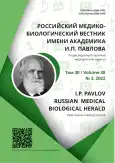Coronary-Vertebral Collaterals in Takayasu Arteritis: Case Report
- 作者: Chupin A.V.1, Zotikov A.E.1, Kutovaya A.S.1, Golovyuk A.L.1, Kharazov A.F.1, Kul’bak V.A.1, Kozhanova A.V.1, Varava A.B.1, Tiimina I.E.1
-
隶属关系:
- National Medical Research Center of Surgery named after A. Vishnevsky
- 期: 卷 30, 编号 3 (2022)
- 页面: 387-396
- 栏目: Clinical reports
- URL: https://journals.rcsi.science/pavlovj/article/view/104656
- DOI: https://doi.org/10.17816/PAVLOVJ104656
- ID: 104656
如何引用文章
详细
INTRODUCTION: PNonspecific aortoarteritis is a rare autoimmune disease with the involvement and narrowing of the aorta and its branches leading to ischemia of the respective arterial region. In the territory of the Russian Federation, the most common manifestation of Takayasu nonspecific aortoarteritis is lesion of the branches of the aortic arch, which in rare cases leads to development of the so called “bald arch” syndrome. In response to hypoxia, intersystemic collaterals are formed through the neoangiogenesis or redirection of the blood flow from the occluded vessels to small-diameter vessels. In patients with “bald arch” syndrome, the key role in blood supply to the brain is played by the vertebral arteries. Here, collateral blood supply is realized through the intersystemic anastomoses, most often through the anastomotic leaks between the intercostal and internal thoracic arteries. In the literature, single cases of formation of collaterals between coronary and bronchial arteries are reported. The article presents a clinical case of coronary-vertebral anastomoses in a patient with extremely severe course of Takayasu arteritis with occlusion of the brachiocephalic trunk, right common carotid artery (CA), left common CA, right internal CA, left internal CA (“bald arch” syndrome). The probable cause of such course of the disease was late referral for medical help by the patient and lack of adequate basic therapy.
CONCLUSION: The demonstrated case is the fourth case in the world literature describing the existence of collaterals between the coronary arteries and cerebral arteries, and the first case in the world describing the existence of collaterals from the right and left coronary arteries to the vertebral artery. Such unusual pathway of collateral blood supply in the patient is explained by the absence of the possibility for collateral compensation from the systems of subclavian and intercostal arteries, severe chronic cerebral ischemia. Usually, the causes of angina pectoris in patients with nonspecific aortoarteritis are spread of arteritis to the coronary arteries, insufficiency of the aortic valve, hypertrophy of the left ventricle. In the described case, none of these conditions was present, and angina can only be attributed to the existence of unusual collaterals and the development of a transient steal syndrome.
作者简介
Andey Chupin
National Medical Research Center of Surgery named after A. Vishnevsky
Email: achupin@rambler.ru
ORCID iD: 0000-0002-5216-9970
SPIN 代码: 7237-4582
MD, Dr. Sci. (Med.), Professor
俄罗斯联邦, MoscowAndrey Zotikov
National Medical Research Center of Surgery named after A. Vishnevsky
Email: kutovaya7@ya.ru
ORCID iD: 0000-0002-1688-7756
SPIN 代码: 3921-9584
MD, Dr. Sci. (Med.), Professor
俄罗斯联邦, MoscowAleksandra Kutovaya
National Medical Research Center of Surgery named after A. Vishnevsky
编辑信件的主要联系方式.
Email: kutovaya7@ya.ru
ORCID iD: 0000-0001-7910-6665
SPIN 代码: 5444-6636
MD
俄罗斯联邦, MoscowAleksandr Golovyuk
National Medical Research Center of Surgery named after A. Vishnevsky
Email: algolovyuk@inbox.ru
ORCID iD: 0000-0001-6830-7832
SPIN 代码: 9976-7041
MD, Cand. Sci. (Med.)
俄罗斯联邦, MoscowAleksandr Kharazov
National Medical Research Center of Surgery named after A. Vishnevsky
Email: harazik@mail.ru
ORCID iD: 0000-0002-6252-2459
SPIN 代码: 5239-8127
MD, Cand. Sci. (Med.), Associate Professor
俄罗斯联邦, MoscowVladimir Kul’bak
National Medical Research Center of Surgery named after A. Vishnevsky
Email: kulbachok@mail.ru
ORCID iD: 0000-0001-6743-4012
SPIN 代码: 1111-0538
MD, Cand., Sci. (Med.), Associate Professor
俄罗斯联邦, MoscowAnzhelika Kozhanova
National Medical Research Center of Surgery named after A. Vishnevsky
Email: k.a.b87@mail.ru
ORCID iD: 0000-0002-0607-6570
MD
俄罗斯联邦, MoscowAleksey Varava
National Medical Research Center of Surgery named after A. Vishnevsky
Email: prankster.win@mail.ru
ORCID iD: 0000-0002-2823-5325
SPIN 代码: 5511-4629
MD
俄罗斯联邦, MoscowIrina Tiimina
National Medical Research Center of Surgery named after A. Vishnevsky
Email: timina68@mail.ru
ORCID iD: 0000-0001-7026-9417
MD, Doc. Sci. (Med.), Professor
俄罗斯联邦, Moscow参考
- Takayasu M. A case with peculiar changes of the central retinal vessels. Acta Societatis Ophthalmologicae Japonicae. 1908;12:553–4. (In Japan).
- Pokrovskiy AV. Zabolevaniya aorty i eye vetvey. Moscow: Meditsina; 1979. (In Russ).
- Pokrovskiy AV, Zotikov AE, Yudin VI. Nespetsificheskiy aortoarteriit (bolezn’ Takayasu). Moscow: Iris’; 2002. (In Russ).
- Hayashi T, Deguchi K, Nagotani S, et al. Cerebral ischemia and angiogenesis. Current Neurovascular Research. 2006;3(2):119–29. doi: 10.2174/156720206776875902
- Hardman RL, Lopera JE, Cardan RA, et al. Common and rare collateral pathways in aortoiliac occlusive disease: a pictorial assay. AJR. American Journal of Roentgenology. 2011;197(3):W519–24. doi: 10.2214/AJR.10.5896
- Sumitani T, Genda A, Kanaya H. Case of aortitis syndrome with collateral circulation from the coronary artery and right bronchial artery to the lung. Kokyu to Junkan. Respiration & Circulation. 1982;30(11):1167–72. (In Japan).
- Kaguraoka H, Itaoka T, Itou H, et al. A case of aortitis syndrome with anastomoses from left coronary artery to bronchial artery. Kokyu to Junkan. Respiration & Circulation. 1989;37(5):569–72. (In Japan).
- Uzunlar B, Karabulut A, Dogan Z, et al. Coronary-carotid artery collateral formation in Takayasu ’ s arteritis: First reported case in the literature. Journal of Cardiology Cases. 2014;9(4):151–3. doi: 10.1016/j.jccase.2013.12.010
- Masugata H, Yasuno M, Nishino M, et al. Takayasu's arteritis with collateral circulation from the right coronary artery to intracranial vessels ― a case report. Angiology. 1992;43(5):448–52. doi: 10.1177/000331979204300514
- Singhal G, Pathak V. Collaterals from Coronary Artery to Carotid and Subclavian Arteries IN Takayasu’s Arteritis: A Rarest Case Reporti. Angiology. 2015;3(3):1000154. doi: 10.4172/2329-9495.1000154
- Pokrovskiy AV. Klinicheskaya angiologiya. Moscow: Meditsina; 2004. (In Russ).
补充文件












